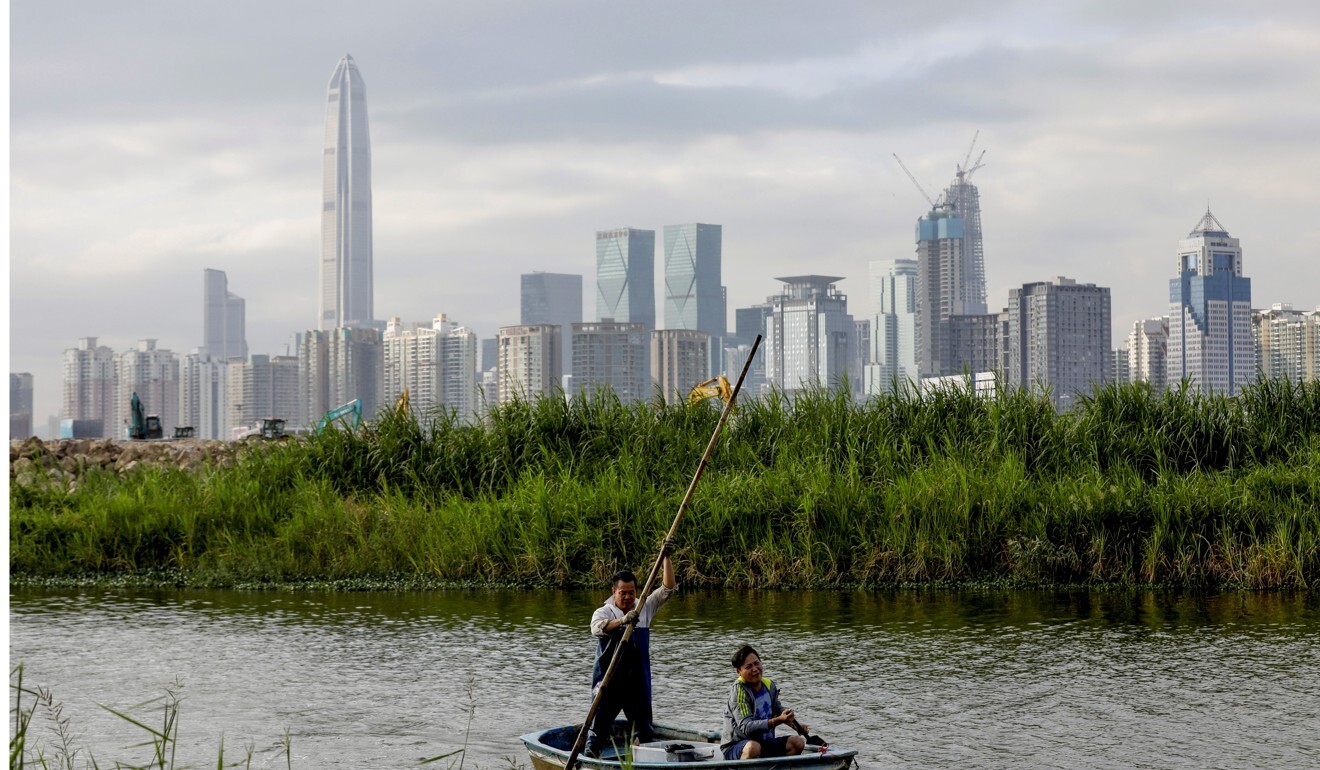
Do China’s new plans for Shenzhen mean a Greater Bay Area back seat for Hong Kong?
- While some analysts fear city could be marginalised by new emphasis on neighbour, others believe the two can complement each other
- Some local businesses, meanwhile, view Shenzhen’s rise as a springboard for growth opportunities on mainland

Under the new five-year plan, issued by the Communist Party and State Council on Sunday, Shenzhen was granted autonomy to make decisions on a wide range of local policies with the aim of becoming the “core engine in the development of the Greater Bay Area”.
The bay area project refers to Xi’s plan to turn Hong Kong, Shenzhen and nine other regional cities into a technological and finance powerhouse.
The plan for Shenzhen, which charts development from 2020 to 2025, also gives the southern Chinese city more autonomy in areas such as land use, technology and innovation, and the hiring of foreign professionals.
The plan calls for Shenzhen to play a leading role in the bay area scheme, including placing it front and centre in “internationalising” use of the yuan and opening up its financial sector.
Shenzhen officials don’t consider Hong Kong an equal partner, but a city with surplus value in helping the special economic zone in developing its financial services sector
The unveiling of the plan came as Shenzhen this week became the first Chinese city to issue its sovereign digital currency to a small group of public users on a lottery basis.
Despite its proximity to and close relationship with Shenzhen, Hong Kong was not specifically mentioned in the blueprint, though the central government did pledge to push “Shenzhen-Hong Kong cooperation to a higher level”.
The central government’s designation of Shenzhen as the “core engine” marks a decided shift from the emphasis placed on Hong Kong in the State Council’s February 2019 plan for the Greater Bay Area.
That blueprint, which set a timetable for having the area “highly connected” by 2035, confirmed that Hong Kong, Macau, Shenzhen and Guangzhou would be the four key cities for regional development.
Hong Kong was mentioned 102 times in the document, while Shenzhen appeared just 39 times.
Under that plan, the central government pledged to “consolidate and enhance Hong Kong’s status as an international finance, transport and trade centre, as well as an international aviation hub”.

Shenzhen’s primary role would be as a special economic zone and home to China’s innovation and technology giants.
Andrew Fung Ho-keung, chief executive of think tank the Hong Kong Policy Research Institute, said Hong Kong had been sidelined in the central government’s new blueprint for Shenzhen.
“It appears Hong Kong’s role is only complementing Shenzhen in its further development,” he said.
Veteran China watcher Johnny Lau Yui-siu said it showed Beijing no longer saw Hong Kong as the “dragon head” in the bay area’s development.
“Shenzhen officials don’t consider Hong Kong an equal partner, but a city with surplus value in helping the special economic zone in developing its financial services sector,” he said.
The high hopes for Shenzhen stand in sharp contrast with Beijing’s recent approach to Hong Kong, which was rocked by months of anti-government protests last year. The central government’s response to the unrest has been to impose a sweeping national security law on the city outlawing acts of subversion, secession, terrorism or collusion with foreign forces.
The central government’s document released on Sunday is primarily about Shenzhen’s development over the next five years. It’s natural that Hong Kong is not highlighted
Economically, Shenzhen surpassed Hong Kong for the first time in 2018, and last year, its gross domestic product was 2.69 trillion yuan (US$400 billion), some 8 per cent higher than Hong Kong’s HK$2.87 trillion (US$370 billion).
In the nation’s 13th five-year plan, which spans 2016 to 2020, Beijing pledged its support for Hong Kong in consolidating and elevating its position as an international finance, transport and trade hub. It also committed to help develop Hong Kong into an international legal, arbitration and mediation services centre.
The plan laid out continued backing for Hong Kong as an offshore yuan trading centre and an international asset management nexus, and underscored an intention to increase value in such sectors as finance, trade, logistics and professional services.
But Fang Zhou, research director of the One Country Two Systems Research Institute, a Hong Kong think tank, disagreed with Fung and Lau. Fang said the relationship between Shenzhen and Hong Kong should not be viewed as a zero-sum game.
“The central government’s document released on Sunday is primarily about Shenzhen’s development over the next five years. It’s natural that Hong Kong is not highlighted in the blueprint,” he said.
Fang pointed to the fact that a Communist Party plan to turn Shenzhen into a model of “high-quality development, an example of law and order and civilisation”, unveiled in August last year, had already designated the city as the “core engine” of the bay.
“But the central government has been stressing that Hong Kong’s unique role is irreplaceable. Shenzhen’s top officials are also keen on stepping up cooperation with Hong Kong,” said Fang, who acts as an adviser to the Shenzhen municipal government.
He said the latest blueprint stated Beijing’s support for collaboration with the international community on the development of digital currency.
Chinese President Xi Jinping tipped to visit Shenzhen this week, stress reforms ahead of plenum
“Although the document doesn’t name any names, Hong Kong is obviously the major partner for cooperation on the matter,” Fang said.
Anthony Cheung Bing-leung, Hong Kong’s former secretary for transport and housing, also said Hong Kong and Shenzhen could complement each other, even if competition was unavoidable.
“The two cities will become bigger winners only through further cooperation,” he said.
Cheung, now research chair professor of public administration at Education University, also noted Hong Kong still had comparative advantages in financial services and aviation. Apart from the question of Hong Kong’s potential marginalisation, academics were divided over whether Beijing still values Hong Kong as much as before the current US-China tensions.
Zheng Tianxiang, a professor at the Centre for Studies of Hong Kong, Macau and the Pearl River Delta at Sun Yat-sen University in Guangzhou, said Hong Kong’s role in the country’s economic development had been diminished by the US using it as a pawn in its anti-China campaign.
Will the Greater Bay Area benefit Hong Kong’s economy?
In July, the US scrapped the city’s preferential trading status in response to Beijing’s imposition of the national security law.
But Fang said the central government now attached even greater importance to the strength of Hong Kong’s financial services industry due to those tensions.
“We are expecting more mainland Chinese companies to launch initial public offerings in Hong Kong in the years ahead as US adopts an unfriendly attitude towards mainland firms listing on the New York Stock Exchange,” he said.
Some in the Hong Kong business sector, meanwhile, have chosen to focus on the positive in their next-door neighbour’s rise.
Shenzhen’s strengthened role as a testing ground will facilitate us tapping into their giant market in the [Greater Bay Area]
Local fintech firm Roots views Beijing’s “gift package” for Shenzhen not as a threat, but as a green light to more business opportunities.
Established in 2018, Roots developed the city’s first digital mortgage platform in partnership with 18 local banks.
Its founder, Joe Cheng Cho-fong said that strengthening Shenzhen’s role as a global leader in technology and finance would have the effect of encouraging other mainland sectors to embrace more innovative financial solutions.
“A key potential partner is the banking sector on the mainland. Shenzhen’s strengthened role as a testing ground will facilitate us tapping into their giant market in the [Greater Bay Area],” said Cheng, whose firm uses technology to analyse individuals’ financial profiles before recommending personalised mortgage plans provided by banks.
He said he believed Hong Kong’s edge as a middleman between the international and Chinese market could not be replaced by Shenzhen in the near future, given the city’s legal system and international connections.
“It will take a long time for any testing ground to grow mature and gain recognition from the international community. Investors are still sceptical about Shanghai’s role as a financial hub even after decades of development,” he said.
To maintain Hong Kong’s competitiveness, Cheng said he hoped the authorities would scale up assistance to innovative local firms and help them establish connections with mainland counterparts.
Harris Sun Chi-chun, founder and CEO of Raspect, a Hong Kong start-up that uses artificial intelligence to save time and costs in property inspection, also said it was pointless for the two neighbouring cities to compete over who would maintain pole position in the bay area plan.
The company set up a branch in Shenzhen a few years ago.


